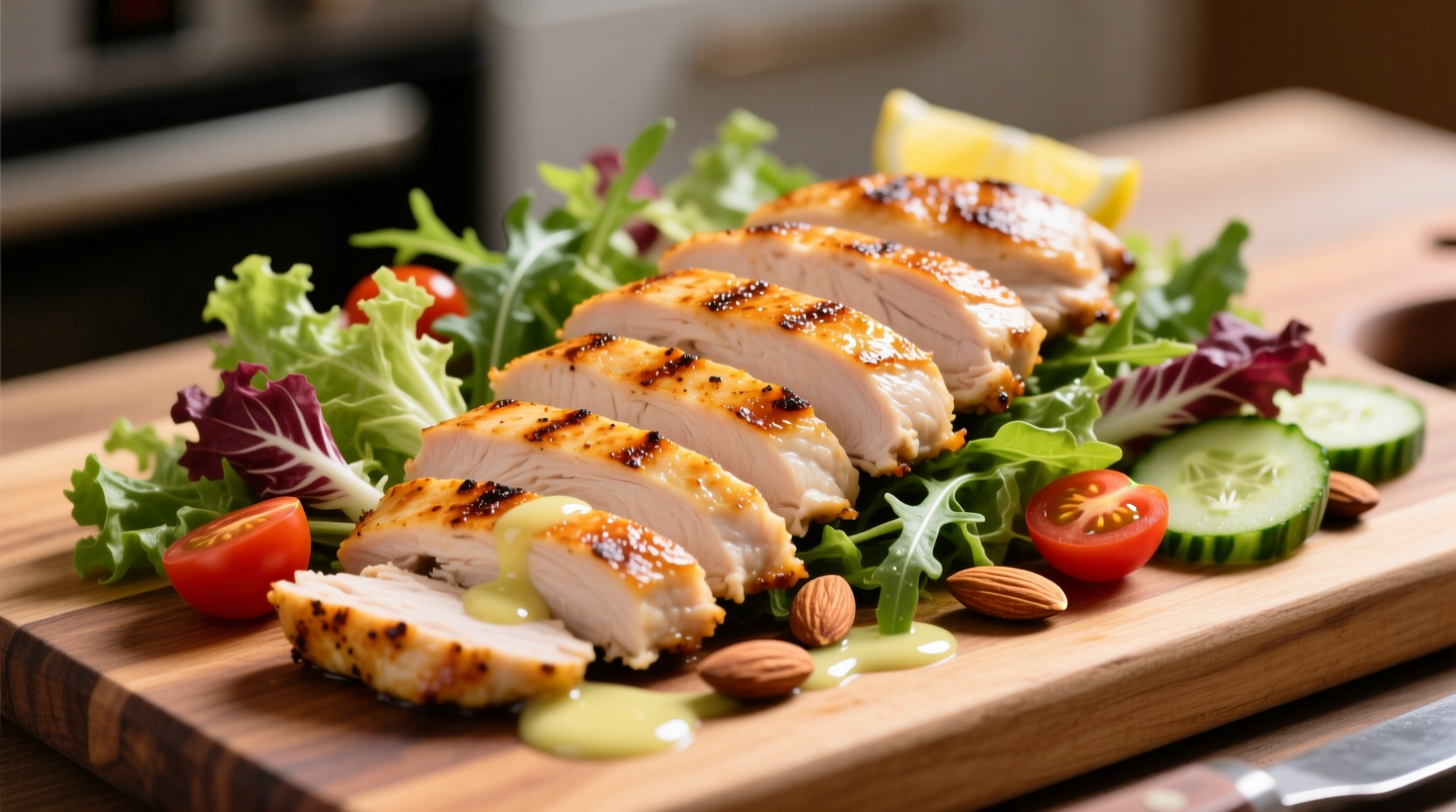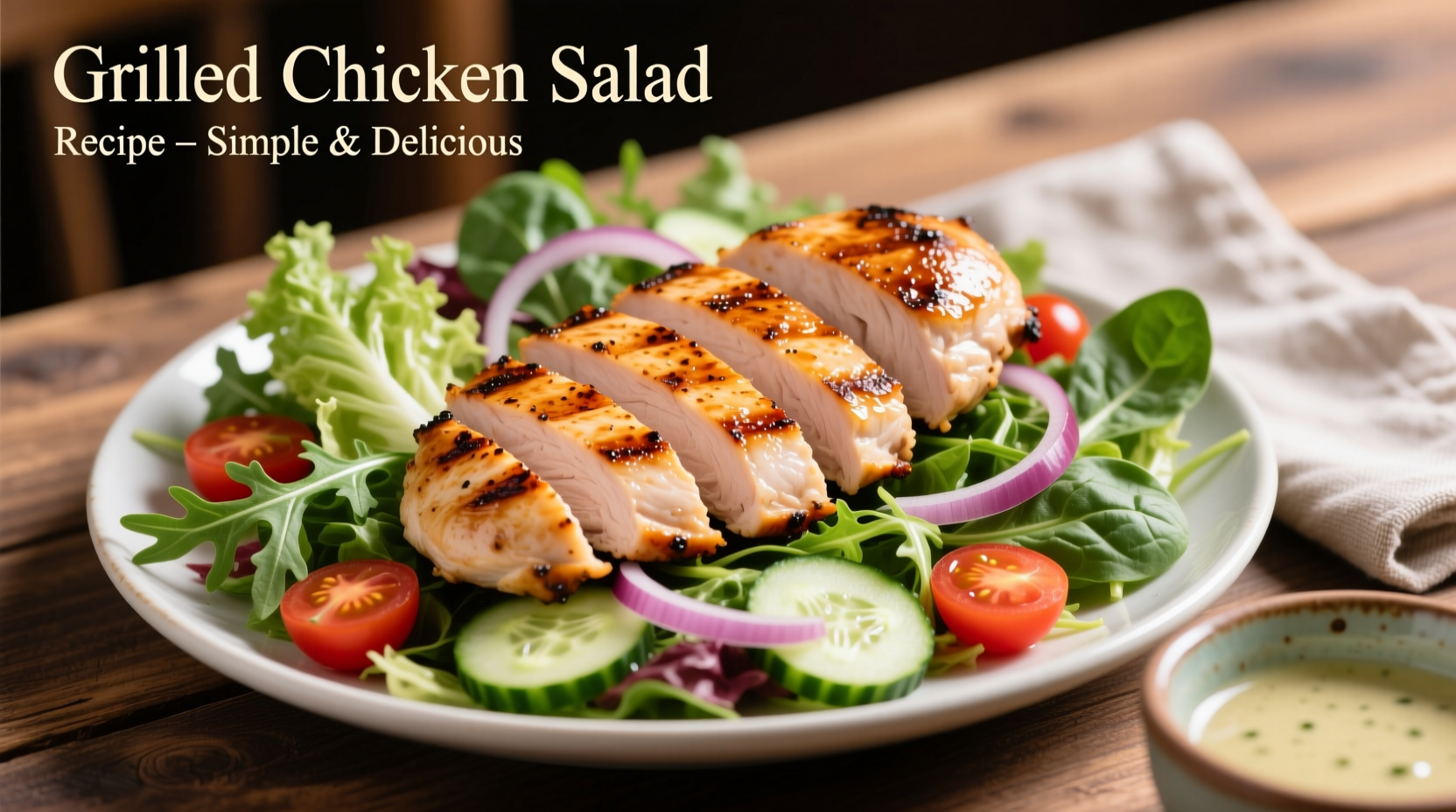Perfectly cooked chicken for salad requires reaching 165°F internal temperature while maintaining moisture. The best methods are poaching, grilling, or baking boneless breasts with proper resting time. Season simply with salt, pepper, and herbs to complement salad ingredients without overpowering them.
Why Proper Chicken Cooking Matters for Salads
When you're preparing chicken for salad, texture and flavor balance are critical. Overcooked chicken becomes dry and stringy, while undercooked chicken poses serious food safety risks. The ideal salad chicken should be moist, tender, and seasoned to enhance—not dominate—the other ingredients in your salad.
Choosing the Right Chicken Cut
Not all chicken cuts work equally well in salads. Here's what you need to know:
- Boneless, skinless breasts: Most popular for salads due to lean profile and ease of slicing
- Thighs: More flavorful and forgiving (less likely to dry out), but higher in fat
- Tenders: Convenient pre-cut option, but can overcook quickly
| Cooking Method | Time Required | Best For | Moisture Level |
|---|---|---|---|
| Poaching | 12-15 minutes | Meal prep, chicken salad | ★★★★☆ |
| Grilling | 6-8 minutes per side | Summer salads, smoky flavor | ★★★☆☆ |
| Baking | 18-22 minutes | Large batches, consistent results | ★★★☆☆ |
| Pan-searing | 5-7 minutes per side | Quick meals, flavorful crust | ★★★☆☆ |
Step-by-Step Cooking Process
Preparation Essentials
Before cooking, properly prepare your chicken:
- Uniform thickness: Pound breasts to even ¾-inch thickness using a meat mallet or rolling pin
- Dry surface: Pat chicken completely dry with paper towels for better browning
- Seasoning timing: Salt chicken at least 15 minutes before cooking to allow penetration
Cooking Methods Compared
Each cooking technique offers different results for salad applications:
Poaching (Best for Meal Prep)
This gentle cooking method yields consistently moist chicken ideal for salads. Fill a skillet with enough broth or water to cover chicken, add aromatics like garlic and herbs, bring to a simmer (not boil), then add chicken. Maintain temperature at 160-170°F for 12-15 minutes until internal temperature reaches 165°F. The USDA Food Safety and Inspection Service confirms 165°F is the safe minimum internal temperature for poultry.
Grilling (Best for Flavor)
Preheat grill to medium-high (375-400°F). Brush chicken with light oil to prevent sticking. Grill 6-8 minutes per side, turning once, until internal temperature reaches 165°F. Let rest 5 minutes before slicing against the grain. Grilled chicken adds wonderful smoky notes to summer salads but requires careful monitoring to prevent drying.
Baking (Best for Large Batches)
Preheat oven to 400°F. Place chicken on parchment-lined baking sheet. Bake 18-22 minutes until internal temperature reaches 165°F. For extra moisture, try baking in a covered dish with ¼ cup broth. Baking provides consistent results when preparing chicken for multiple salads.

Critical Food Safety Information
Following proper food safety guidelines is non-negotiable when cooking chicken. The USDA mandates that all poultry must reach 165°F internal temperature to eliminate harmful bacteria like salmonella and campylobacter. Always use an instant-read thermometer inserted into the thickest part of the chicken, avoiding bone. Never rely on color alone to determine doneness—undercooked chicken can appear white while still unsafe.
Resting and Slicing Techniques
Resting time significantly impacts moisture retention. After cooking, let chicken rest for 5-7 minutes before slicing. During this critical resting period, the muscle fibers relax and reabsorb juices that would otherwise escape when cut. For salads, slice against the grain into ¼-inch strips for optimal tenderness. Cutting with the grain creates long, tough fibers that are unpleasant in salads.
Seasoning Strategies for Salad Chicken
When seasoning chicken specifically for salads, less is often more. Strong flavors can overwhelm delicate salad components. Consider these approaches:
- Simple salt and pepper: Allows other salad ingredients to shine
- Herb-infused: Rosemary, thyme, or tarragon complement greens
- Lemon-herb: Bright flavors that pair well with vinaigrettes
- Avoid heavy marinades: Sugary or acidic marinades can cook the surface
Storage and Meal Prep Tips
Properly stored, cooked chicken keeps well for salad preparation. Cool chicken completely within 2 hours of cooking, then store in airtight containers in the refrigerator for up to 3-4 days. For best texture in salads, add dressing to chicken separately from other salad components until ready to serve. If preparing chicken in advance, slightly undercook by 5°F as carryover cooking will continue during resting.
Troubleshooting Common Problems
Even experienced cooks encounter issues with salad chicken. Here's how to fix them:
- Dry chicken: Try brining in 4 cups water with ¼ cup salt for 30 minutes before cooking
- Uneven cooking: Use a meat mallet to create uniform thickness
- Bland flavor: Add aromatics to poaching liquid or rub with herbs before cooking
- Overcooked edges: Reduce heat and cook more gently
Perfect Pairings for Chicken Salads
Consider these flavor combinations when building your salad:
- Mediterranean: Feta, cucumber, olives, red onion with lemon-herb chicken
- Asian-inspired: Mandarins, almonds, sesame dressing with ginger-scallion chicken
- Classic Cobb: Bacon, avocado, blue cheese with simply seasoned grilled chicken
- Southwest: Black beans, corn, avocado with cumin-lime chicken











 浙公网安备
33010002000092号
浙公网安备
33010002000092号 浙B2-20120091-4
浙B2-20120091-4